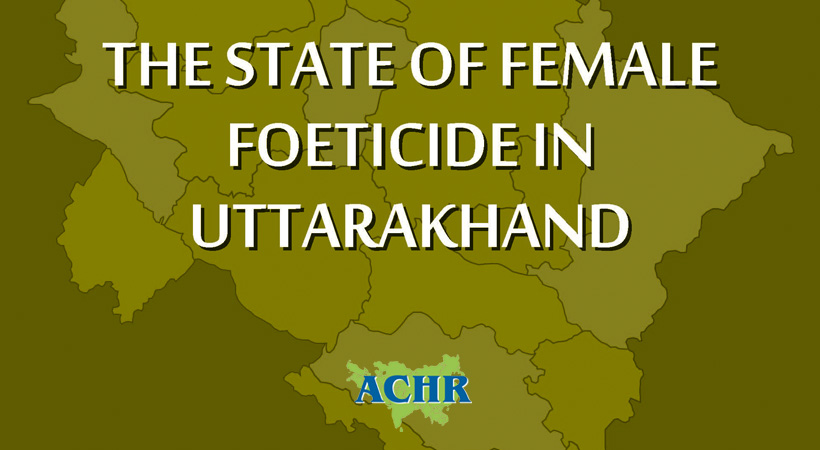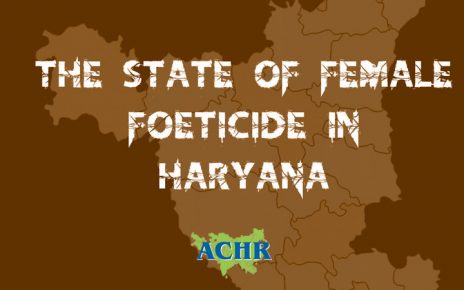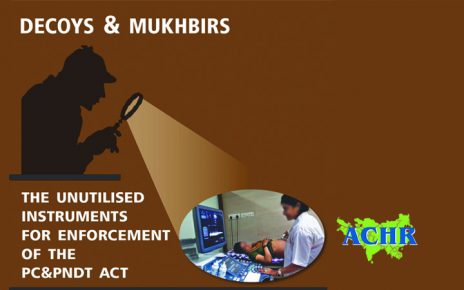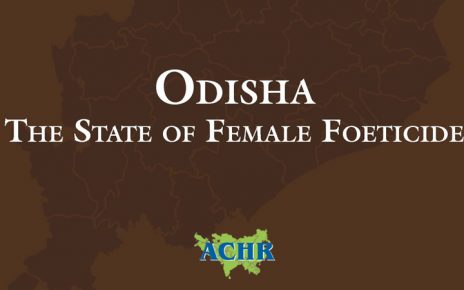India has been severely affected by declining child sex ratio (CSR) especially since 1981 as a result of collusion between technology to detect sex of the foetus in early stage of pregnancy and traditional preference for boys. As per the Government of India, some of the reasons for low child sex ratio are son preference and the belief that it is only the son who can perform the last rites, that lineage and inheritance run through the male line, sons would look after parents in old age, men are the bread winners etc. Exorbitant dowry demand has caused female foeticide/infanticide. Indeed, many of these harmful patriarchal practices were legalised in independent India and women were not allowed to inherit properties until the Hindu Succession (Amendment) Act, 2005 came into force in September 2005.
Uttarakhand has the 7th lowest CSR among 35 States/UTs of India as per 2011 census with CSR of 890 girls per thousand boys, a drastic decline from 908 as per 2001 census. The Annual Health Survey (AHS) conducted by the Registrar General & Census Commissioner of India, which is claimed to be the largest demographic survey in the world, shows little improvement of the CSR in Uttarakhand. The sex ratio at birth (SRB) as per the AHS was respectively 861 in 2011-2012 and 867 during 2012-2013 in Uttarakhand. If under-five mortality rate (U5MR) of 48 deaths per 1,000 births in India is taken into account in Uttarakhand context, the CSR in Uttarakhand would have reduced to 813 in 2011-2012 and 819 in 2012-2013. If the current abysmal state of implementation of the measures to combat female foeticide continues, the CSR in Uttarakhand will fall drastically to a little over 800 by 2021 census.
As per the statement of Health Minister of India Mr J P Nadda before the parliament on 3 March 2015 during 2009 to December 2014, not a single conviction was secured under the Preconception and Pre-Natal Diagnostic Techniques (Prohibition of Sex Selection) Act (PCPNDT Act) in Uttarakhand. The possibilities of the Medical Termination of Pregnancy Act (MTP) being abused for sex selective abortion remain high.
The Nanda Devi Kanya Yojana (NDKY) launched in 2009 and renamed as Hamari Beti Hamara Abhiman (HBHA) in 2014 failed to achieve its primary objectives to reduce gender imbalance in child sex ratio, prevent female foeticide and provide social and economic security to girl child. The scheme itself is designed not to have any impact. The NDKY is extended only to Below Poverty Line (BPL) families while the Above Poverty Line (APL) families who use and can afford sex selective abortion are completely left out. Even for the BPL families, the NDKY covered only 4.97% of the BPL families. As per the BPL survey conducted by the Government of Uttarakhand during 2011-2012, there were a total of 6,19,718 BPL families but as per the Uttarakhand government’s own admission, in 5 years from 01.01.2009 to 31.12.2015, only 30,830 girls or 4.97% were given benefits under the NDKY. In terms of those born, as per 2011 census, a total of 2,50,803 females in the age group of 0-2 years or an average of 83,601 girls are born annually in Uttarakhand. If only 30,830 beneficiaries were extended benefits under the NDKY from 01.01.2009 to 31.12.2015, it implies that 6,166 girls were given benefits annually against the birth of 83,601 girls i.e. 7.37% of the girls born annually.
There are serious doubts whether actual beneficiaries are benefitting at all under the Nanda Devi Kanya Yojana. The utilization certificates (UCs) of the NDKY provided to Asian Centre for Human Rights by the authorities under the Right to Information Act seem to have been prepared only to be shared under the RTI Act. All except one UC submitted by District Program Officer (DPO), Almora, all other UCs have no date, reference number and in some cases, official stamp. In the absence of all these, authenticity of the UCs is highly doubtful. There are serious doubts whether the benefits under the scheme are being given to actual beneficiaries.
Asian Centre for Human Rights recommends the following to the State Government of Uttarakhand:
- Revise the ‘Nanda Devi Kanya Yojana, renamed as Hamari Beti Hamara Abhiman Scheme, to increase the amount for post birth benefits and include scholarship and further provide additional financial assistance for marriage of the surviving girls;
- Remove the condition of covering only upto 2nd girl child and expand the coverage of the Hamari Beti Hamara Abhiman Scheme to include all girl children;
- Remove the condition provided under the Hamari Beti Hamara Abhiman Scheme that upon the demise of the girl child the accumulated benefits under the scheme shall be forfeited and transferred back to the Government;
- Remove the income ceiling of parents and cover all girls under the benefits of the Hamari Beti Hamara Abhiman Scheme irrespective of their parents’ income;
- Link the Hamari Beti Hamara Abhiman Scheme with all Anganwadi Centres and Schools to monitor the progress of the beneficiaries;
- Undertake specific programme for increasing coverage of all families under the Hamari Beti Hamara Abhiman Scheme by connecting the programme with all hospitals/primary health centres;
- Digitalise the list of beneficiaries and related information, funds sanctioned and utilization certificates and upload the same in the website of the District concerned; and
- Undertake effective measures to monitor and ensure proper implementation of the PCPNDT Act and MTP Act.




